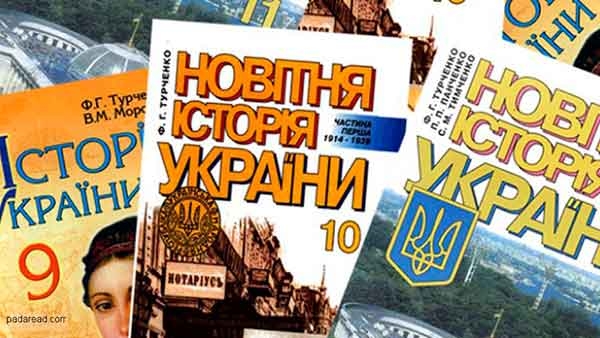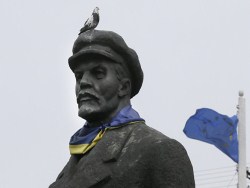
This is not Ukraine Russian fed, Russia for its efforts and labors have created the present-day Ukraine
The myth that Soviet Ukraine Russian fed, he still lives.
This myth was used by nationalists in the late 80-ies and in the fateful for the Soviet Union 1991, to convince the population of Ukraine, that without Russia they will be much richer.
The same myth is currently the interim government in Kiev, urging their fellow citizens that, just completely broke away from Russia and concluding a Treaty with the European Union, they will be able to dramatically improve their well-being.
So whether Ukraine fed Russia? This is very typical statement of the Ukrainian policy Andrey Ilyenko:
“Ukrainian resources fed, fed Russia to the suburbs, fed puppets and the Communist parties around the world: in Africa, in Asia – Communist regimes, terrorist in all corners of the world. Here it used the Ukrainian natural resources.
This view is echoed by no less svidomye “scientists” of the same in Kiev, which are now carefully counted how many “klyatyh Muscovites” in all the years of the Soviet Union, the Ukrainian ate bacon and bread…
I don’t know what they are missing is a serious science in the nationalist Kiev no longer exists, where science turned into a pathetic ideological servants of power.
The real historical facts show exactly the reverse of the picture drawn by these “scientists”.
The “famine” of the Soviet sample
Begin with an interesting observation of Russian economist Yevgeny Ladik, made in 70-ies: “the Phrase that Ukraine is “the breadbasket of the Union,” seemed to be true. Moreover, in the Newspapers this phrase walked everywhere. The Newspapers and the people at the time trusted.
As it turned out, in vain! After touring all over the country from Minsk to Yakutsk, in 15 years I never found products from Ukraine. Campfire stew we ate the Kurgan, Altai, the Chinese. The shops sold pepper from Bulgaria, from Hungary cucumbers, bacon from the same French hens, canadian bread, Cuban sugar…
Even Mongolian yaks ate, but the famous Ukrainian fat – never. About the famous wines of Massandra I just heard and saw the Bulgarian, Hungarian, Algerian, at least Krasnodar. Armenian, Azerbaijani, Uzbek cognac sold everywhere, and vodka tasted just arrived for the first time in the Ukraine.
When Ladik came to Ukraine, it just struck local food abundance. In the free market were the most diverse varieties of oils, cheeses, sausages, meat etc. At that time the Russian Soviet Federative Republic, all that was in short supply. The box this puzzle opened simply – with the permission of the Moscow Ukrainian Republic that produced, and consumed, without removal of the limits.
At the same time, the Russian Federation had almost all of its agricultural products to donate to Union funds. Meat alone gave Russia a year almost 800 thousand tons (the rest of the Republic together – no more than 400 thousand tons).
That is, the Soviet Ukraine, is very rich in its agricultural and land and resources, fed only one a favorite! But that was not all.
Then, the distribution of the Soviet income in the form of various kinds of subsidies, loans and other payments, vividly describes Russian economist Oleg Platonov: “Every citizen of the RSFSR produced in a year of goods and services for 17 thousand 500 dollars, and consumed 11 thousand 800 dollars. Thus every Russian man contributed about $ 6,000 a year in favor of other national republics…
As a result of redistribution occurred, roughly speaking, the robbery of the Russian people, whereby the inhabitants of many of the ethnic regions consume much more than they produce by their labor”. That is, the people of the Russian Federation Union center received far less than they produce.
While the national republics observed exactly the opposite pattern. Ukraine was no exception – according to official Soviet statistics, donations in her were two times higher than what the Republic actually earned.
Here are the numbers causes known article “Who will feed the USSR: “Despite the fact that the bulk of the gas extracted in other parts of the country, the Baltic and Ukrainian village gasification, significantly ahead of the Russian. By the time of the collapse of the Soviet Union almost all the villages of Baltic, Ukraine and Transcaucasia were gasified… In the 1950-1980-ies the level of wages and other social benefits in most Union republics was 30-45% higher than in Russia (RSFSR). For example, the cleaning lady in Tallinn or Kiev in the 1970s-1980s received not less than $ 100 net, while the “average q” of the Russian engineer in the RSFSR clean barely gained 120 rubles. But the level of retail prices in the RSFSR was above 20, and even 40% in comparison with most other Soviet republics…
Rents in the Russian Federation has always been higher than in most other Soviet republics. Even the official standards of living space in the Russian Federation were lower than for the Baltic States, Transcaucasia, Ukraine, the capital cities of the republics of Central Asia. As for saturation, USSR imports of consumer – relevant decisions of the Politburo of the CPSU Central Committee and the Presidium of the Council of Ministers of the USSR 1959, 1963, 1978 and 1983 provided for strict priority: the import of consumer goods to direct primarily in non-Slavic Union republics and Ukraine, then to Belarus, the Autonomous Republic of the RSFSR, and in the first place – in the North Caucasus. Then – in the national Autonomous regions and districts of RSFSR.
It is in the said sequence. It was only after all this, that by “a residual principle” – the rest officially Russian territory of the Russian Federation…”
Thus, the entire Soviet Union, including Ukraine, lived off the labor of indigenous inhabitants of Russia, whose standard of living because of such “justice” was falling steadily from year to year
Flights Khrushchev
Not only Russian, but also many Western scholars believe that the Soviet government would benefit it Ukraine. Its not only the lure of the Union center, it is not only allowed to keep their own agricultural products.
Due to the efforts of the Soviet Union have created a Republic and the most advanced and high-tech industries!
That reference, taken from contemporary historical data:
“Over the years, the first Soviet five-year plans of the USSR into a mighty industrial power. Constructed the largest factories equipped with modern technology (“Zaporizhstal” in Zaporozhye, Azovstal in Zhdanov (now Mariupol), the Krivoy Rog metallurgical in Krivoy Rog, the Kharkov tractor), many mines and other enterprises. Was commissioned one of the largest in the world Novo-Kramatorsk machine-building factory and other machine factories in the Donbass, Kharkov, Odessa and other cities.
Again on a new technical basis has created chemical, machine-building and metal-working industries…
Thus, Ukraine to the late 80-ies became an industrial power with a diversified industry and the largest allied base not only coal, steel and food industries, and machine building, chemistry, electricity…”
The question arises: where Kiev has been such privileges as the region of consumption, which in industrial development?
I think, for one simple reason – since the death of Stalin until the mid 80-ies, the Soviet Union was ruled by Ukrainian clans ! That is, people from there the party circles. According to former KGB General Philip Bobkov, it all started with Nikita Khrushchev: “Long time has worked in Ukraine and enjoyed the support of the Ukrainian colleagues, Khrushchev clearly continued to flirt with them. He strongly emphasized his love for Ukraine, starting with the embroidered shirts and attempts to promote the corn to the North.
When Khrushchev began actual rehabilitation of the Bandera movement, when many members of the nationalist underground was not just rehabilitated, but they even opened access to the authorities.
Here is what writes on this occasion, the historian Igor Leonidov: “estimates of the number of North American and West German sources (including existed in the 1950s – early 1970s the Munich Institute for the study of the USSR and Eastern Europe), at least one-third of Ukrainian nationalists and members of their families, rehabilitated in the second half of 1950, became by the mid-1970s, leaders of district committees, regional committees, regional and/or district Executive committees in the Western, Central and South-Western Ukraine. And also the leaders of different ranks in many Ukrainian ministries, departments, enterprises, Komsomol, and public organisations, including the regional level.
Khrushchev also tried to hold in the Republic of another forced Ukrainization, like the one that took place in 20-e years when Kaganovich, Khrushchev wanted to transfer all educational institutions exclusively in the Ukrainian language and Russian studying only optional.
It is not surprising that in the early 60-ies of the CPSU Central Committee received an anonymous letter in which were these words: “…In Ukraine, all the more heating up the atmosphere on the basis of the national question, in connection with the desire of someone in Kiev to conduct a so-called ukrainisation of schools and universities… Is in the CPSU is not clear that the violation of any of the status quo, and especially in this matter in Ukraine, will cause hostile relations between Russians and Ukrainians, will excite very many base passions in favor of and for the needs of Ukrainian nationalists?..”
One is stagnation and the other a gas
New total Ukrainization was not held only due to the fact that in 1964, Khrushchev was overthrown. However, in other areas of his Pro-Ukrainian policy continued. Apparently, because the authorities in the country took another Ukrainian clan – Dnepropetrovsk, headed by Leonid Brezhnev.
Ukraine was the first of the Soviet republics, which produces gas. In Dashava (Lviv oblast — ed.) began to produce gas in the 20-ies of the last century. Then was laid a gas pipeline Dashava-Drohobych. Then, during the Second World war, the Germans started to build a gas pipeline from Dashava through Poland to Berlin, but they lost the war, and after the war, the pipeline was dismantled, and laid the gas pipeline Dashava-Kyiv, then — Dashava-Moscow.
Bandera still continued unhindered entry into power, with the result that nationalist rhetoric among local chiefs and intellectuals only increased. In General, personnel policy in Ukraine had its essential features.
General Bobkov says: “unlike other republics of the Ukraine, from the point of view of the exchange, remained closed for Moscow, Kiev, Dnepropetrovsk and other Ukrainian cities to work in Moscow and the Russian Federation was visited by the leaders of various ranks. Ukraine is the Russians to themselves almost did not accept. Even those few of our employees of the KGB, who were sent to work in the Republic, often returning back”.
With regard to economic preferences, Moscow continued to make the country more and more lavish gifts. For example, in the construction in the 1970’s-early 1980-ies – Soviet gas export pipelines. They built their whole country, but they have been laid primarily through the territory of the Ukrainian SSR.
Perhaps this is no coincidence – this building has allowed not only to gasify the whole country, but also to put these lines under actual Ukrainian control.
Historian Igor Leonidov has drawn attention to the fact that the fact that the laying of gas pipelines through Ukraine are very pleased by the Ukrainian emigre Diaspora living in Western Europe and the United States: “Many of the media of the Ukrainian Diaspora in that period and later noted that after Ukraine gained its “independence” she will be able to dictate terms to Russia and will keep her on a strong “hook”.
So it actually happened after the collapse of the Soviet Union, when the gas pipeline on Ukrainian soil have become a real curse for the Russian supplies to Europe…
I think that the General conclusion here is quite obvious.
This is not Ukraine Russian fed, Russia for its efforts and works created the present-day Ukraine, which, alas, I gave it to her boorish ingratitude.







